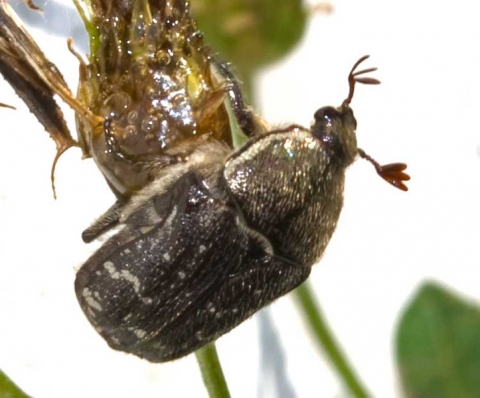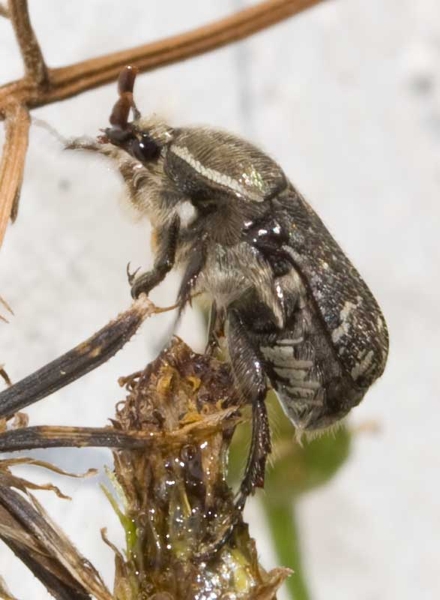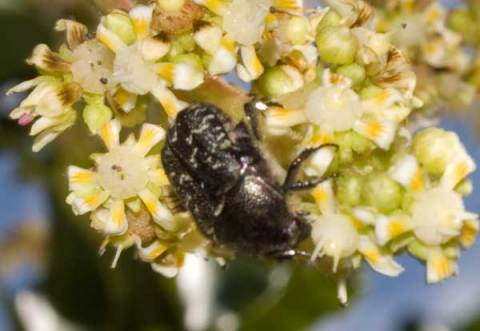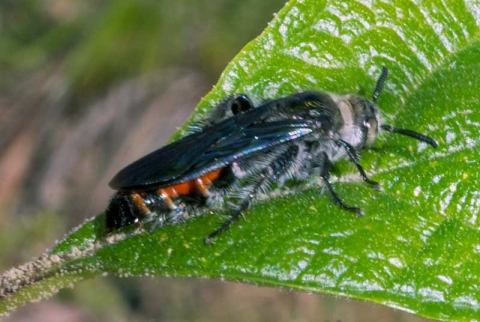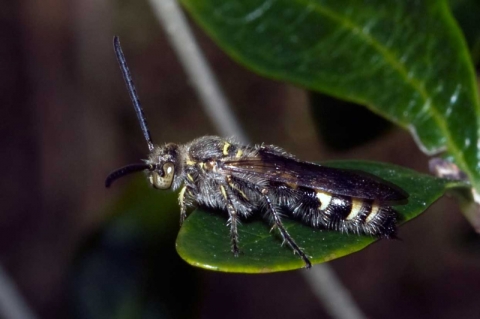I first noticed a curious little beetle the other afternoon; I was out looking for bees and wasps, and it did exactly what bees and wasps tend to do: make a “beeline” for a flowerhead, then settle in on it and gather pollen or nectar. So of course I assumed it was a bee at first, since it was doing what bees do, and it was hairy and it made a sort of buzzing sound in flight.
On closer inspection, though, it turned out to be much boxier than a bee, it had hardened wing cases (all beetles have these; they are known as elytra), and it had the most interesting antennae (the “feathery” shape of these antennae is described as lamellate). Here it is inspecting one of the weedy flowers (Bidens alba, “Spanish Needles”) I like to keep around in case pollinating insects want to come by (One thing that might jump out at you in that photo is the rather sickly looking nature of the flowerhead; I’m not sure what causes that, but I have noticed that many [by no means all] of the flowers these guys visit exhibit this same condition):
The beetle is a flower scarab beetle (family Scarabaeidae, subfamily Cetoniinae), Euphoria sepulcralis, to be precise. The common name is either Dark or Spangled Flower Beetle, depending on whom you believe.
The scarab family is one of the more well-known beetle groups; it’s estimated that there are 30,000 species worldwide.
The ancient Egyptians saw in the sacred scarab (Scarabaeus sacer) the embodiment of the sun god Khepri; apparently its propensity for rolling a dung ball across the ground, burying it, and having new scarabs emerge reminded them of the way the sun rolls across the sky, departs at night, and reemerges in the morning. According to Yves Cambefort (Beetles as Religious Symbols),
The first scarab worshiped, was probably the bright metallic Kheper aegyptiorum. The decisive symbolism came from the association of the dung ball to the sun: the scarab rolling his dung ball provided an explanation of the sun’s movement in the sky. However, this solution was neither “logical” (where is the scarab in the sky?) nor exclusive: Egyptian culture embraced their old and new beliefs with an equal and non conflicting faith.
The capital of the solar religion was the city of On, which Greeks called Heliopolis (“the City of the Sun”). It was probably at On that Khepri, a scarab god of the sun, appeared in the predynastic epoch. Khepri might have been associated with the brilliant Kheper aegyptiorum, (whose name was coined by André Janssens, in 1940) or to the black Scarabaeus sacer, which was more often figured later. Nowadays, only the latter occurs in this region; the former being a more southern species probably due to significant climactic changes since Egyptian civilization. The name Khepri (or Kheperi, or Khepera) means “The Being, The Extant.” The name Khepri is related to other words of the same root, e.g. kheper “to exist, to come to existence” and khepru “transformations, metamorphoses.” Originally, Khepri represented the sun from sunrise to sunset, although the oldest texts describe him setting in the western horizon at dusk. He quickly lost some importance, and became confined to the associative role with the rising sun, which he maintained throughout the entire Egyptian civilization. He is represented as a man with a scarab topping or replacing his head:
Flower scarabs, also known as rose chafers, flower chafers, and flower beetles, represent only a small percentage of the scarab species (only about 4000 species worldwide, and only 20 in the United States, although there are about 105 when you include Canada and Northern Mexico). They are among the more colorful of insects, as this image from Wikipedia demonstrates:
Compared to these gaudy creatures, Euphoria sepulcralis is downright drab, with its dark brown ground color and ivory squiggles. (Pinned specimens look almost black, perhaps accounting for the specific name sepulcralis, of or related to the tomb.) It does have some nice golden hair that is quite pretty in the right light; in fact, that’s probably another reason I mistook this guy for a bee at first glance (FYI, there is another, even more bee-like flower beetle, called—go figure—Bee-like Flower Beetle, Trichiotinus piger. From trichion, Gr. diminutive of hair, and piger, Latin for slow, lazy, reluctant, slothful):
Furthermore, E. sepulcralis occurs in great enough numbers that they can become agricultural pests; the lists of foods they like is quite long. (I first noticed this beetle on Tuesday and now, Friday, I’ve probably seen a dozen, sometimes 4 or 5 at once on my weedy flowers; I can imagine some poor farmer trying to keep his corn safe!)
According to the UF “Featured Creatures” web page for this species,
DPI records for Florida include many for those hosts [roses and corn], with annotations such as “10-15 beetles per ear of corn.” Records also suggest it can be a pest of mango and avocado in South Florida, where large numbers of the beetles destroy the flowers and thus reduce the number of fruits produced. There are also records of the beetles invading bee hives and damaging combs.
There’s a mango tree down the street with what looks like millions of flowers; I suspected that was what was pulling these little guys into the neighborhood, but when I went down to look, I found lots of bees and only one or two beetles. Of course, from ground level, it was pretty hard to see much more than the bottom-most layer of flowers; there could have been dozens crawling around up there rather than the one I got a picture of:
The presence of these flower beetles, for whatever reason they’re here, is most likely what is attracting a parasitic wasp (a scoliid of indeterminate species) that, as far as we know, uses these little guys as prey items:
I’m told by people who know that this individual is a stray from the West Indies (Campsomeris dorsata) and I should keep a close eye out for more of them. The red markings indicate that it’s a female; I saw what could be a male a day later, but there’s no way to distinguish the possible West Indian vagrant from the fairly common North American species C. plumipes, from a photo:
Although these are large wasps, and not particularly uncommon, very little is known about their biology beyond the fact that they parasitize the larvae of scarab beetles.
Another species that enjoys the presence of these fairly clumsy fliers include the curly-tailed lizards (Leiocephalus carinatus, a Bahamian species introduced to Florida in the 1950s) in my front yard. As I was mowing the weeds the other day, I saw one of these beetles depart from a flower in haste. Since this was before the “infestation” began, I was just getting ready to run inside and get my camera when I saw that it was careening right toward a lizard who, sure enough, ran a few steps and chomped it down. Nature, red in tooth and claw, right here in my yard!
To be honest, though, I don’t think it takes much skill to prey on these clumsy beetles. I’ve seen them embedded so hard in a flower head that it would take considerable force to pull them off. I’ve even seen them just clinging on to a stem, dead as doornails.

